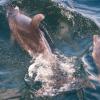Vegetation and Sea-level History of a Mangrove Swamp at Levera Pond, Grenada (2004)
Grenada is a tropical, mountainous island in the Caribbean (12°1'N, 61°4'W).
Levera, a national park on the northeast coast, has a brackish pond (3 m deep, 0.5
km*) and mangrove swamp, sheltered by a beach barrier. Rhizophora fringes the
pond and tidal inlet, followed by an Avicennia zone, mixed mangrove zone, and
Hippomane zone. Surface pollen samples reflect local vegetation, but Rhizophora
and Conocarpus are over-represented, while Avicennia and Laguncularia are under-
represented. Sediment lithology, pollen, and macrofossil analysis indicate that the
mangrove swamp was formerly a bay. Two sediment cores (445 cm long) have a
basal horizon of marine shelly sand, overlain by Rhizophora peat, mixed mangrove
peat, and then clay. A sharp contact between shelly sand and Rhizophora peat
indicates a sudden decrease in energy of deposition. Approximately 2300 years
ago, formation of a beach barrier and accumulation of sediments caused the
mangrove swamp to prograde into the bay. The succession from Rhizophora peat
to mixed mangrove peat indicates a progressive drying of the swamp. In historic
times, forest clearance and agriculture have increased erosion, causing deposition
of clay. Pollen from weeds and Hippomane increase, while Conocarpus declines.
Area of interest: Grenada
Year: 1994




